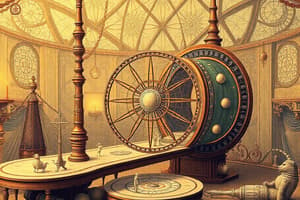Podcast
Questions and Answers
What does the 2nd Law of Thermodynamics state?
What does the 2nd Law of Thermodynamics state?
- Absolute zero cannot be reached.
- Entropy increases in isolated systems. (correct)
- Entropy decreases in isolated systems.
- Energy cannot be created or destroyed.
Which of the following is a characteristic of Strong Nuclear Force?
Which of the following is a characteristic of Strong Nuclear Force?
- It is involved in generating electricity.
- It is responsible for the attraction between masses.
- It holds protons and neutrons together in atomic nuclei. (correct)
- It governs the behavior of charged particles.
In classical mechanics, what does Newton's Second Law define?
In classical mechanics, what does Newton's Second Law define?
- The inertia of an object.
- The gravitational force between objects.
- The conservation of momentum.
- The relationship between force and mass. (correct)
What does the equation PV = nRT represent?
What does the equation PV = nRT represent?
What is the focus of Modern Physics?
What is the focus of Modern Physics?
Which law describes the attraction between masses?
Which law describes the attraction between masses?
What principle explains that position and momentum cannot be measured simultaneously with arbitrary precision?
What principle explains that position and momentum cannot be measured simultaneously with arbitrary precision?
Which equation is used to calculate the energy equivalent of mass?
Which equation is used to calculate the energy equivalent of mass?
Which type of force is responsible for radioactive decay?
Which type of force is responsible for radioactive decay?
What phenomenon is described by the behavior of light and its interactions with matter?
What phenomenon is described by the behavior of light and its interactions with matter?
Flashcards are hidden until you start studying
Study Notes
Key Concepts in Physics
- Definition: Physics is the branch of science that deals with the study of matter, energy, and the fundamental forces of nature.
Major Branches of Physics
-
Classical Mechanics:
- Motion of objects and the forces acting upon them.
- Key concepts: Newton's laws of motion, kinematics, dynamics, and gravitational force.
-
Thermodynamics:
- Study of heat, energy, and work.
- Laws of thermodynamics:
- 1st Law: Conservation of energy.
- 2nd Law: Entropy increases in isolated systems.
- 3rd Law: Absolute zero can't be reached.
-
Electromagnetism:
- Interaction between electric charges and magnetic fields.
- Key principles: Coulomb's Law, Ohm's Law, Maxwell's Equations.
-
Optics:
- Behavior of light and its interactions with matter.
- Key phenomena: Reflection, refraction, lens, and diffraction.
-
Modern Physics:
- Study of atomic and subatomic processes.
- Key theories: Quantum mechanics, relativity.
Fundamental Forces
-
Gravitational Force:
- Attraction between masses; described by Newton’s Law of Universal Gravitation.
-
Electromagnetic Force:
- Force between charged particles; responsible for electricity, magnetism, and light.
-
Strong Nuclear Force:
- Holds protons and neutrons together in atomic nuclei.
-
Weak Nuclear Force:
- Responsible for radioactive decay and neutrino interactions.
Important Equations
- Newton’s Second Law: F = ma (Force = mass × acceleration)
- Equations of Motion (for constant acceleration):
- v = u + at
- s = ut + 0.5at²
- v² = u² + 2as
- Ideal Gas Law: PV = nRT (Pressure × Volume = number of moles × gas constant × Temperature)
- Einstein's Theory of Relativity: E = mc² (Energy = mass × speed of light squared)
Key Principles
-
Conservation Laws:
- Energy, momentum, and angular momentum are conserved in isolated systems.
-
Wave-Particle Duality:
- Light and matter exhibit both wave-like and particle-like properties.
-
Uncertainty Principle:
- In quantum mechanics, the position and momentum of a particle cannot be simultaneously measured with arbitrary precision.
Units of Measurement
- SI Units:
- Length: Meter (m)
- Mass: Kilogram (kg)
- Time: Second (s)
- Electric Current: Ampere (A)
- Temperature: Kelvin (K)
- Amount of Substance: Mole (mol)
- Luminous Intensity: Candela (cd)
Applications of Physics
- Engineering: Design of structures and mechanisms.
- Medicine: Imaging technologies (e.g., MRI, X-rays).
- Technology: Development of electronic devices and renewable energy sources.
Physics: The Study of Matter and Energy
- Definition: Physics is the fundamental science that explores the nature of matter, energy, and the forces that govern the universe.
Major Branches of Physics
- Classical Mechanics: Focuses on the motion of objects and the forces that influence them. Key concepts include Newton's laws of motion, which describe how objects move in response to forces, and the principles of kinematics and dynamics, which analyze motion and its causes.
- Thermodynamics: Deals with heat, energy, and its transformations. Central to this field are the laws of thermodynamics:
- First Law: States that energy cannot be created or destroyed, only transformed from one form to another.
- Second Law: Describes the natural tendency of systems to increase entropy, or disorder.
- Third Law: Posits that absolute zero, a state of complete absence of thermal energy, cannot be reached.
- Electromagnetism: Examines the interaction between electric charges and magnetic fields. Fundamental principles include Coulomb's law, which quantifies the force between charges, and Ohm's law, which describes the relationship between current, voltage, and resistance.
- Optics: Investigates the behavior of light and its interactions with matter. Key phenomena include reflection, refraction, and diffraction, which explain how light bounces off surfaces, bends when passing through different mediums, and spreads out as it passes through openings.
- Modern Physics: delves into the realm of atomic and subatomic phenomena. It encompasses the principles of quantum mechanics, which describes the behavior of matter at the atomic and subatomic level, and relativity, which examines the nature of space, time, and gravity.
Fundamental Forces: The Building Blocks of the Universe
- Gravitational Force: The force of attraction between any two objects with mass. It is described by Newton's law of universal gravitation, which states that the gravitational force between two objects is directly proportional to the product of their masses and inversely proportional to the square of the distance between them.
- Electromagnetic Force: The force experienced by electrically charged particles. This force is responsible for electricity, magnetism, and the behavior of light. It's a much stronger force than gravity at short distances.
- Strong Nuclear Force: The incredibly powerful force that binds protons and neutrons together within the nucleus of an atom. It's the strongest of the four fundamental forces.
- Weak Nuclear Force: Responsible for radioactive decay and certain interactions involving neutrinos. It's weaker than the strong nuclear force, but plays a crucial role in nuclear reactions.
Important Equations: The Language of Physics
- Newton's Second Law of Motion: F = ma. This equation defines the relationship between force (F), mass (m), and acceleration (a). It states that the net force acting on an object is equal to the product of its mass and acceleration.
- Equations of Motion: Used to describe the motion of objects with constant acceleration:
- v = u + at (Final velocity = initial velocity + acceleration x time)
- s = ut + 1/2at² (Distance = initial velocity x time + 1/2 x acceleration x time²)
- v² = u² + 2as (Final velocity² = initial velocity² + 2 x acceleration x distance)
- Ideal Gas Law: PV = nRT. This equation describes the behavior of ideal gases, relating pressure (P), volume (V), number of moles (n), gas constant (R), and temperature (T).
- Einstein's Theory of Relativity: E = mc². This equation describes the relationship between energy (E), mass (m), and the speed of light (c). It highlights the equivalence of mass and energy.
Key Principles: Shaping Our Understanding of the Universe
- Conservation Laws: In an isolated system, certain quantities remain constant over time. These include:
- Conservation of Energy: The total energy of an isolated system remains constant.
- Conservation of Momentum: The total momentum of an isolated system remains constant.
- Conservation of Angular Momentum: The total angular momentum of an isolated system remains constant.
- Wave-Particle Duality: Light and matter display both wave-like and particle-like properties.
- Uncertainty Principle: In quantum mechanics, it is impossible to measure both the position and momentum of a particle with perfect accuracy simultaneously.
Units of Measurement: Providing a Common Language
- SI Units: The International System of Units (SI) is a system of units used worldwide for scientific and engineering purposes. Key SI units include:
- Length: Meter (m)
- Mass: Kilogram (kg)
- Time: Second (s)
- Electric Current: Ampere (A)
- Temperature: Kelvin (K)
- Amount of Substance: Mole (mol)
- Luminous Intensity: Candela (cd)
Applications of Physics: Shaping Our World
- Engineering: Physics plays a vital role in the design and construction of structures, machines, and systems.
- Medicine: Advances in imaging technologies, like MRI and X-rays, rely heavily on physical principles.
- Technology: The development of electronic devices, from smartphones to computers, and renewable energy sources are heavily influenced by physics and its principles.
Studying That Suits You
Use AI to generate personalized quizzes and flashcards to suit your learning preferences.




